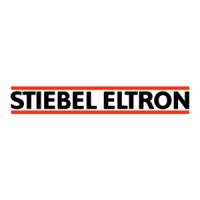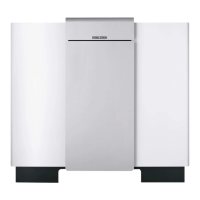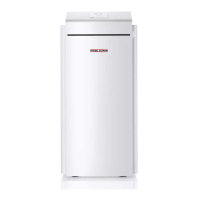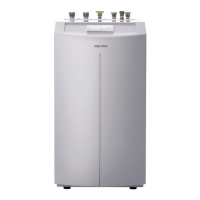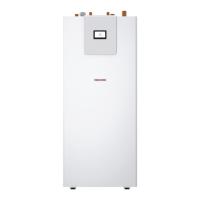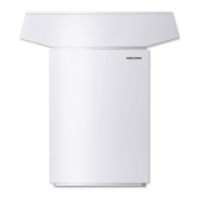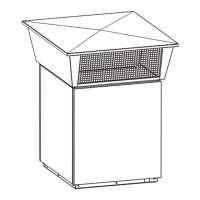23
2.9.4 Installation of the heat utilisation
system
2.9.4.1 Heating circuit
The heat utilisation system must be installed
in line with current technical guidelines. For
safety equipment on the heating system, con-
sult DIN 4751 page 2 or local regulations.
Prior to connecting the heat pump, check the
heating system for leaks, flush it thoroughly,
fill and carefully vent it.
When filling the heating system with heating
water, observe VDI 2035, sheet 1 [or local
regulations]. Particularly ensure that
z during the service life of the system, the
total fill and top-up water must not exceed
three times the nominal content of the
heating system,
z the total alkaline earths in the water must
be < 3.0 mol/m³,
z the total water hardness must be < 3
mmol/l
z the water must be softened, if the above
requirements are not met.
Generally soften the heating water if the speci-
fic system content is > 20 l/kW output (e.g. in
case of system with buffer cylinder).“
Check the correct connection of heating flow
and return (Fig. 5). The reduction of structure-
borne vibrations on the water side requires
the installation of flexible pressure hoses (for
part no. see section 2.3).
Implement thermal insulation in accordance
with local regulations.
2.9.4.2 Buffer cylinder
A buffer cylinder is recommended to ensure
trouble-free heat pump operation. The buffer
cylinder provides hydraulic separation of the
volume flow in the heat pump circuit and the
heating circuit.
The volume flow in the heat pump circuit
remains constant if, for example, the volume
flow in the heating circuit is reduced by ther-
mostatic valves.
2.9.4.3 Circulation pump (cylinder loading
pump)
The cylinder loading pump is integrated into
the WPF. Consider the available external head
of 2.8 m when sizing the anti-vibration ele-
ments and the pipework between the heat
pump and the buffer cylinder.
When utilising the WPF for DHW heating,
ensure that the connection between the heat
pump and the DHW cylinder are sized so that
the total pressure drop outside the heat pump
is less than the available external head of 2.8
m.
2.9.4.4 Circulation pump (central heating
pump)
If no cylinder (buffer cylinder) is used, con-
sider the maximum external pressure of
280 hPa when sizing the heating circuit.
Ensure the rated volume flow of the heat
pump under all operating conditions of the
heating system by installing an overflow valve.
2.9.4.5 Heat meter
Observe the additional pressure drop when
installing heat meters on the heating side. The
sives inside the heat meters are easily blocked
by the dirt particles in the heating circuit, fur-
ther increasing the pressure drop.
2.9.4.6 Oxygen diffusion
Corrosion can affect steel components, when
non-impermeable plastic underfloor heating
system pipes are used with steel radiators,
steel pipes or DHW cylinders.
The product of corrosion, i.e. rusty sludge, can
settle inside the heat pump evaporator and
can result in output loss through a reduction
of cross-section or in a heat pump shutdown
triggered by the high pressure limiter.
Therefore, never use heat pumps type WPF in
conjunction with underfloor heating systems
with non-impermeable pipes.
2.9.4.7 Scaling
Water quality, operating conditions and the
water volume are decisive factors to the extent
of scaling. To prevent damage to valves, heat
exchanger and heating elements, check the
water condition and assess it in accordance
with VDI 2035 [or local regulations].
Note: An awareness of hardness in
accordance with the Detergent Act [Germany]
is insufficient. Decisive for scaling is the
concentration of calcium hydrogen carbonate,
which can be supplied by your water supply
company.
2.9.4.8 DHW heating
For DHW heating, a DHW cylinder with inter-
nal indirect coils is recommended (see special
accessories).
A three-way diverter valve is integrated into
the WPF between the DHW heating circuit and
the central heating circuit. Connect the upper
coil connection of the DHW cylinder to the
DHW flow of the WPF (see Fig. 5).
Connect the lower coil connection of the DHW
cylinder to the WPF return. For this, insert a
tee immediately behind the anti-vibration joint
connected directly to the WPF. With this tee,
join the central heating and the DHW heating
circuits.
2.10 Power supply
Notify your local power supply company of the
electrical connection.
Only qualified electricians must carry out the
installation in accordance with these instruc-
tions.
Before any work, isolate the equip-
ment from the power supply at the
control panel
Observe VDE 0100 and the regulations of your
local power supply company.
The WPF must be able to be separated from
the mains power supply by an additional iso-
lator, which disconnects all poles with at least
3 mm contact separation. For this purpose,
use contactors, mains isolators, fuses, etc. on
site.
Terminals are located inside the WPF control
panel (Fig. 9 and 10). The terminals become
accessible by removing the front cover
(Fig. 3) and opening the front panel. To open
the front panel, remove the fixing screws on
the side at the top of the control panel. When
removing the front cover ensure, that the ca-
bles, which connect the heat pump manager
with the control panel, are not torn off.
Remove the lid to enable the equipment to be
connected (Fig. 3).
Assemble these components in reverse order.
For this, observe the following:
– After closing the front panel, tightly se-
cure this to the control panel using the
fixing screws and serrated washers.
– When fitting the front cover secure it,
as shown in Fig. 4, to the side panels
(screws and serrated washers included
in the pack supplied).
– Route all connecting cables and sensor
leads through the apertures in the back
panel (item 7, Fig. 5).
The compressor must only turn in
one direction. Should the WPMi
display indicate the fault No power during
start-up, interchange the cores of two phas-
es to change the rotational direction.
After connecting all electrical cables, refit and
seal the cover over the mains terminal strip
(X3) (Fig. 9 and 10).
Terminal rating of the electrical supplemen-
tary heater
Mark the box in front to the relevant terminal
rating on the label below the type plate.
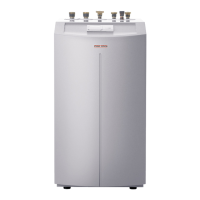
